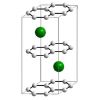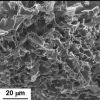Carbon-based Materials group

Structure of graphite intercalation compounds such as superconducting MC6

Ultra-pure single-wall carbon nanotubes (HiPco): metallic and carbon impurities have been removed by an efficient one-pot treatment under a gaseous mixture of chlorine and oxygen

Nitrogen-doped graphene foam: platinum-free catalyst for oxygen reduction reaction of proton exchange membrane fuel cell
Last publications
- Charge transfer in alkaline-earth metal Graphite Intercalation Compounds
Justine Zinni, Luigi Camerano, Lucie Speyer, Sébastien Cahen, Inass El Hajj, Mickaël Bolmont, Ghouti Medjahdi, Philippe Lagrange, Gianrico Lamura, Gianni Profeta, Claire Hérold
Carbon, 2024, 230, pp.119652. ⟨10.1016/j.carbon.2024.119652⟩ - Poly(dicarbon monofluoride) (C2F)n bridges the neutron reflectivity gap
Valery Nesvizhevsky, Killian Henry, Louise Dauga, Batiste Clavier, Sylvie Le Floch, Egor Lychagin, Alexei Muzychka, Alexander Nezvanov, Vittoria Pischedda, Cole Teander, Kylyshbek Turlybekuly, Silvana Radescu, Brigitte Vigolo, Sébastien Cahen, Claire Hérold, Jafaar Ghanbaja, Kirill Zhernenkov, Marc Dubois
Carbon, 2024, 227, pp.119249. ⟨10.1016/j.carbon.2024.119249⟩ - Flexible fluorinated graphite foils with high content of (C2F)n phase for slow neutron reflector
Killian Henry, Marie Colin, Gabin Chambery, B. Vigolo, Sébastien Cahen, Claire Hérold, Valery Nesvizhevsky, Sylvie Le Floch, Vittoria Pischedda, Sam Chen, Marc Dubois
Dalton Transactions, 2024, 53 (22), pp.9473-9481. ⟨10.1039/D4DT00794H⟩
Presentation
Due to the great diversity of carbon materials and their strong application potential in a wide variety of fields, the group conducts researches on bulk materials and nanomaterials. The research activities are focused on:
- the synthesis and design of new materials and their multi-scale characterization,
- the modification of their properties by developed chemical treatments,
- the applications of these materials, mainly in the field of energy storage and conversion.
The group is more specifically interested in low dimensional crystalline materials: graphite and related structures, graphene and its derivatives, carbon nanotubes, etc. The work also includes more disordered carbon materials, such as hard carbons, carbon blacks and activated carbons. The chemistry that is carried out leads to:
- new intercalation compounds within 2D structures and their remarkable physical properties,
- graphenic materials in powder form or dispersed in a liquid medium,
- “tailor-made” functionalized carbon surfaces,
- ultra-pure carbon materials, etc.
The materials are characterized, with the support of the laboratory's technical platforms, by various techniques (X-ray diffraction, electron microscopies, spectroscopic methods, magnetic measurements, etc.), often coupled. The team also relies on thermal analysis equipment (TGA, TGA-MS, DSC) and has expertise in the textural study of carbon materials by adsorption of various probe molecules (N2, CO2, Kr). More specific characterizations such as, for example, ion beam analysis are carried out in collaboration with NIMBE.
Research topics
Intercalation into low-dimensional carbon materials
Intercalation, a soft-chemistry method, enables a modification of the composition, structure and properties of 2D, 1D or 0D host materials. The group develops synthesis methods for the preparation of new graphite (or related materials) intercalation compounds. For bulk materials, a good knowledge of the crystallography of the as-obtained original compounds is a strong asset for the study of the remarkable physical properties of some of these materials (collaboration with CNR-SPIN): superconductivity, anisotropy… Moreover, intercalation applied to powdered carbon materials represents a step towards the elaboration of nanomaterials by chemical or physical exfoliation methods.
Thesis:
Université de Lorraine doctoral fellowship, 2018-2021, Inass El Hajj
Articles:
- Topotactic mechanisms related to the graphene planes: chemical intercalation of electron donors into graphite, S. Cahen et al., Eur. J. Inorg. Chem. 2019, 45, 4798-4806.
- Intercalation of sodium and heavy alkali metals into graphenic foams. L. Speyer et al., Micropor. Mesopor. Mat. 2020, 306, 110344.
- Original synthesis route of bulk binary superconducting graphite intercalation compounds with strontium, barium and ytterbium. S. Cahen et al., New J. Chem. 2020, 10050-10055.
- Intercalation of barium into graphite by molten salts method: Synthesis of massive samples for crystal structure determination of BaC6. I. El Hajj et al., Carbon 2022, 186, 431-436.
Carbon nanomaterials: synthesis and chemical treatments
The properties of carbon materials such as carbon nanotubes, graphene or graphenic materials strongly depend on their structural and chemical characteristics. The conducted research focuses on the elaboration of carbon nanomaterials as well as the development of specific chemical treatments. The objective is to control the chemical, structural and textural characteristics of these materials at different scales in order to optimize their application potential. In particular, heteroatom doping or surface functionalization are powerful approaches that need to be adapted to the targeted use of the developed material. The integration of these nanomaterials in various matrices is also a way to develop materials with specific properties. Multi-technique characterization allows to understand the relevant parameters and the involved chemical mechanisms.
Projects:
- ANR CAMFRE (2021-2025)
- ExfoGraph Maturation Project funded by SATT Sayens (2021-2023
Thesis:
ANR CAMFRE, 2022-2025, Lucas Magniez (with 201 team)
Articles:
- Functionalization and exfoliation of graphite with low temperature pulse plasma in distilled water. A. Létoffé, et al. Phys. Chem. Chem. Phys. Physical Chemistry Chemical Physics 2022, 24, 5578-5589.
- Synthesis and Characterization of Graphene-Based Inks for Spray-Coating Applications, D.S. Saidina et al, J. Electron. Mater. 2019, 48, 5757-5770.
Patent:
Exfoliation of graphite and functionalization of graphene by plasma process in liquid. S. Cuynet, M. Ponçot, S. Fontana, A. Letoffé, T. Belmonte, G. Henrion, C. Hérold, I. Royaud, FR2020479, 2020.
Study of the surfaces of carbon materials
The surface properties of carbon nanomaterials are of great importance as their high surface area plays a major role in their properties. The adsorption of gases (such as N2, Kr, CO2), a non-destructive technique, is used to characterize the entire accessible surface of a sample. Textural properties, such as specific surface area, pore size or total pore volume are analysed using isotherms by classical methods (BET) but also by the density functional theory (2D-NLDFT). This latter allows a better understanding of the porous structure of microporous carbons. By using krypton as an adsorbate, the preferential character of the functionalization can be especially probed which is difficult to evidence by other analytical techniques.
Thesis:
Co-tutelle Université de Lorraine - Université d’Abomey-Calavi (Bénin), 2018-2021, Elie Sogbochi
Articles:
- Energy and matter balance of process of activated carbon production from Algerian agricultural wastes: date palm rachis and jujube stones. P. Girods et al. Biomass Conversion and Biorefinery 2021, 11, 1537-1554.
- Non-covalent and covalent immobilization of Candida antarctica lipase B on chemically modified multiwalled carbon nanotubes for a green acylation process in supercritical CO2, M. C. Bourkaib et al., Catalysis Today 2019.
- Adsorption ability of activated carbons from Phoenix dactylifera rachis and Ziziphus jujube stones for the removal of commercial dye and the treatment of dyestuff wastewater, M. Daoud et al., Microchemical Journal. 2019, 148, 493-502.
Carbon materials for energy
Carbon-based materials are involved in numerous technologies for alternative energy storage and conversion. Elaboration and chemical treatments of carbon materials realized by the group are especially oriented to the practical use of the new designed materials. Various kinds of materials are studied:
- hard carbons with controlled porosity for metal-ion batteries electrodes,
- nitrogen-doped graphene foams for platinum-free catalysts in proton exchange membrane fuel cells,
Projects :
- ICEEL EBNaR 2020-2022
- LUE IMPACT ULHyS (2017-2020)
Theses:
- Lorraine Université d’Excellence, 2017-2020, Lilian Moumaneix
- Université de Lorraine doctoral fellowship, 2021-2024, Loris Raspado
Articles:
- Real-time mass spectroscopy analysis of Li-ion battery electrolyte degradation under abusive thermal conditions. B. Gaulupeau et al. Journal of Power Sources 2017, 342, 808-815.
- Nitrogen-doped graphenic foam synthesized by solvothermal-based process: Effect of pyrolysis temperature on the material properties, L. Moumaneix et al., Micropr. Mesopor. Mat. 2020, 110165.
- Metal-free nitrogen-doped graphenic materials as cathode catalysts for the oxygen reduction reaction in polymer electrolyte membrane fuel cells. L. Moumaneix et al. Journal of Applied Electrochemistry 2021, 51(5), 727-738.
Know-how
Elaboration and treatment of materials
- Intercalation chemistry (solid-solid, solid-liquid, solid-gas)
- Alkali metals chemistry
- Deposition of condictive inks
- Handling of highly air-sensitive materials under controlled atmosphere (vacuum or inert gas) with dedicated equipments: glove boxes and vacuum devices (glass blowing)
- Thermal treatments under vacuum until 1500°C, under inert gas until 2800°C, under argon pressure until 1000°C
- Thermal treatments under reactive atmosphere (Cl2, Cl2/O2, H2)
Study and characterization of materials
- Structural and textural characterizations: X-ray diffraction, TEM, SEM
- 1D modelling of stacking sequences in 2D materials
- Monitoring of chemical modifications (functionalization, doping, purification, annealing …) by Raman spectroscopy, XPS, TGA, TGA-MS
- Quantitative analysis of surface properties by adsorption volumetry (N2, Kr, CO2…)
Innovation
Exfoliation of graphite and functionalization of graphene by plasma process in liquid. S. Cuynet, M. Ponçot, S. Fontana, A. Letoffé, T. Belmonte, G. Henrion, C. Hérold, I. Royaud, FR2020479, 2020.
Members
CNRS researchers
- Claire HEROLD
Professors, assistant professors
- Sébastien CAHEN
- Sébastien FONTANA
- Lucie SPEYER
- Fabrice VALSAQUE
Post-doctoral researchers
- Romain CHEVIGNY
- Oumaima HATIM
PhD students
- Mélodie BECKER
- Loris RASPADO
- Stane VIAUD
- Justine ZINNI
Emeritus
- Guy FURDIN
- Philippe LAGRANGE
Publications
Contact
Head of the group
Sébastien CAHEN
sebastien.cahen@univ-lorraine.fr
+33 (0) 3 72 74 25 41
Nancy-Artem
Institut Jean Lamour
Campus Artem
2 allée André Guinier - BP 50840
54011 NANCY Cedex
